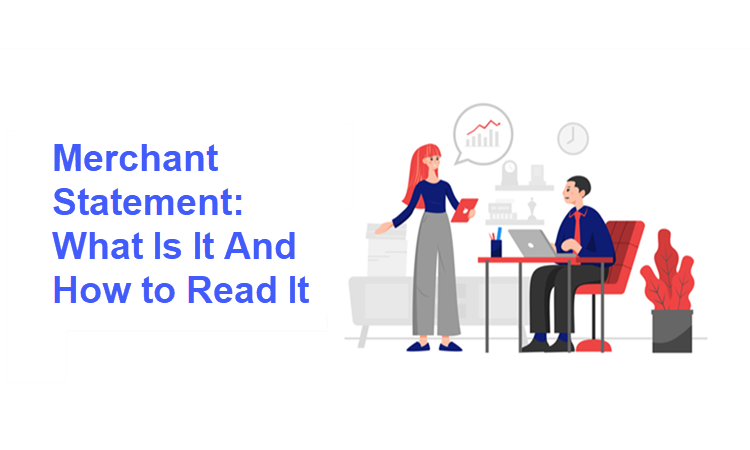To track payment fees and client transactions, merchants must learn how to read merchant statements and identify the most important information for effective financial management.
Merchants that understand the importance of continuous financial monitoring base their decisions on such information and are more likely to succeed in the contemporary ecommerce environment.
This article explains what a merchant statement is, what elements it contains, and how to read a merchant statement and make impactful business decisions.
What Are Merchant Statements?
A merchant statement is a financial report that lists the total transaction volume, sales activity, processing fees charged to a merchant account within a particular month.
Merchant statements help merchants closely monitor their financial activities and plan their budgets accordingly. In the case of client disputes, such as chargebacks or refunds, merchant statements provide all the necessary information that merchants need in order to settle the dispute.
How to Get a Merchant Statement?
Payment service providers deliver merchant statements to merchants on a predefined schedule, typically once a month. Merchants receive the merchant statement either by mail to their business address or electronically via email.
Different payment processors use different names for merchant statements, such as Merchant Account Statement, Credit Card Processing Statement or Merchant Processing Statement. Regardless of its name, a merchant statement contains valuable data on sales activity, processing fees and chargeback disputes.
Why Is It Important to Properly Understand Merchant Statements?
Understanding what each piece of information in a merchant statement means helps merchants in the following aspects:
- Monitoring the cash flow. Knowing how many customers have paid for subscriptions, memberships, and other similar services ensures simpler tracking of recurring revenue and other income. Comparing the income and costs gives a better insight into the cash flow, laying the groundwork for further financial planning.
- Handling chargebacks. Businesses receiving a high number of chargebacks may be qualified as high-risk merchants by credit card associations. Consequently, they need to open a high-risk merchant account to receive payments, which is more complicated and costs more assets and time than opening a regular merchant account. Reading a merchant statement thoroughly eliminates the risk of overlooking a chargeback complaint and provides potential evidence for disputing the chargeback request.
- Determining processing fees. Pay special attention to payment processing charges listed in the merchant statement to fully understand what you’ve paid for and whether you can reduce the costs. For example, merchants often decide not to accept rewards credit cards because they incur higher processing costs.
How to Read a Merchant Statement?
Pay special attention to several sections of the merchant statement and read it meticulously to understand the most important information.
Note: How a merchant statement looks may differ from processor to processor. The data presented in this guide is only for general reference.
Note the Merchant Number
The merchant number is usually placed at the top of the monthly merchant statement, along with the payment provider’s contact data and statement month.
The merchant number is equally important as your business name and address. Payment processors may ask you to submit these three elements to confirm your identity when updating your information on file.
Check the Summaries
There may be one or more summary sections at the top of the merchant statement. These summaries typically contain all the information on the payments conducted during the statement period. Due to different settlement dates, the actual funding may not match the current bank account balance.
The summary sections in a merchant statement typically include the following items:
- Total amount paid
- Third-party payments
- Chargebacks
- Fees
- Total amount processed (based on previous elements)
Settlement Report
The settlement report presents data on settled credit card payments by different card type. If a merchant receives payments from customers using Visa, MasterCard, and AmEx, this report contains the number and type of transactions for each payment card type.
Determine Processing Fees
Payment processing fees depend on the type of payment card used, total transaction volume, and the type of merchant account (high risk or low risk).
There are two main elements of the payment processing fee - markup and wholesale fee.
- Markup. The markup fee is the charge that merchants pay to the payment processor for processing services.
- Wholesale fee. The wholesale base cost is a credit card processing fee collected by the card-issuing banks and the card associations.
These two types of fees are typically separated in a merchant statement, so that merchants know how much they’re paying to receive their clients’ payments. Ask your payment service provider to send you a merchant statement with independently listed wholesale and markup fees if they're not separated.
Identify the Pricing Model
Merchants need to know what pricing model the payment service provider uses to charge them for the payment processing services. These are the most common pricing models:
- Interchange-plus. Interchange-plus is a frequently used pricing model in payment processing. A merchant statement containing this model presents the costs in the form of wholesale and markup fees. Both types of fees are clearly presented for every single transaction.
- Subscription/membership. A subscription or membership pricing model is similar to Interchange-Plus. The markup fee is charged as a monthly subscription fee, and there’s also a separate per-payment fee. This pricing model pays off to merchants receiving larger transactions, since it reduces their total processing costs.
- Flat rate. In a flat-rate pricing model, the processing costs are the same for every payment a merchant receives. There are no tiers and monthly fees, which is a double-edged razor. For some merchants, this is a favorable model, while others end up paying high transaction costs.
- Tiered pricing. A tiered pricing model is based on different tiers of services. Each tier comes at a different price. Payment processors using this model divide their merchants into three categories based on the merchant’s ability to meet the processor’s particular criteria:
- Qualified merchants. Qualified merchants are low-risk businesses.
- Non-qualified merchants. Non-qualified merchants are the high-risk ones from the processor’s point of view, and they pay the highest fees.
- Mid-qualified merchants. Mid-qualified businesses are somewhere in between.
Get familiar with the tiers to know exactly how the payment processor qualifies your business and determines the rates for your payments.
Monitor Merchant Account Transactions
In addition to a merchant statement, merchants should have electronic access to their merchant accounts.
Monitoring your merchant account transactions daily or weekly and then going through the monthly statement ensures fraud prevention and improves your entire business management.
Conclusion
Merchants need to ensure receiving money as quickly and cost-effectively as possible. Payment processors are here to help them reach that objective. They prepare merchant statements and send them to merchants, providing in-depth information on customers’ payments within a specified period.
The explanations, definitions, and practical tips shared above help merchants break down their merchant statements to advance their business operations altogether.




